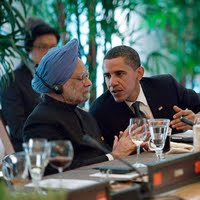WPR piece on Indian strategist's take on China-US "term sheet" effort
 Wednesday, March 9, 2011 at 10:41AM
Wednesday, March 9, 2011 at 10:41AM  Piece by Saurav Jha in World Politics Review on piece K. Subhramanyam wrote on the term sheet just before he died.
Piece by Saurav Jha in World Politics Review on piece K. Subhramanyam wrote on the term sheet just before he died.
I excerpt the parts that included by rebuttals, which I gave Saurav via emails.
With Indian newspapers still carrying obituaries of the country's strategic doyen, K. Subhramanyam, who passed away in February after almost a half-century at the forefront of New Delhi's strategic debates, it is worth considering the object of Subhramanyam's concern during his final days: the implications for India of a proposed U.S.-China grand strategy agreement hammered out by a group of policy experts in Washington and Beijing. The document proposed a series of strategic compromises between China and the U.S., including a massive Chinese investment in the U.S. economy in return for an informal nonaggression pact, particularly with regard to the U.S. military's posture toward China in Taiwan. Indian analysts led by the late Subhramanyam, however, saw the proposal as a ploy by the Chinese to "use the U.S. to attain hegemonic power in Asia."
In the proposal, Subhramanyam heard echoes of the Nixon-Deng compact, born out of the expediency of the Cold War. That agreement saw the United States push huge sums of commercial technology investment into China, ultimately followed by the outsourcing of mass manufacturing. Now, by contrast, it is high technology that would be transferred to China in return for the $1 trillion that Beijing would invest in the U.S. private sector. Over time, these transfers would enable China to leverage its demographic advantages to become the world's dominant economy.
However, Thomas P.M. Barnett, one of the proposal's architects, rejected the significance of China's advantage in absolute demographic numbers. "The volume of bodies no longer determines strength in this world, especially when hundreds of millions of [those bodies] are impoverished, as they are today and will remain for decades in China," said Barnett. "It is much smarter to consider age." As Barnett explained, both China and the United States currently have a median age of 36. But with China aging four times as quickly as the U.S., its median age will hit 48 in 2050, while the U.S. will only have reached 39 . . .
Subhramanyam highlighted the fact that, despite spelling out agreements on Taiwan and Iran, the strategic proposal is completely silent on Pakistan and its nuclear and missile-technology relationship with China. He questioned whether that amounted to conceding Pakistan and South Asia to the Chinese sphere of influence. Barnett disputes that interpretation. "The proposal wasn't meant to be universally inclusive," he says, "but to reference only those issues that created deep strategic mistrust between the U.S. and China. [For the U.S.], Pakistan doesn't qualify, for obvious reasons" . . .
The timing of the strategic proposal was also suspect in Subhramanyam's eyes, who felt that its release just after Obama's visit to India was an attempt by Beijing to tempt Washington away from New Delhi with the offer of a major U.S economic bailout. His prescription was for India to move more quickly on forging closer ties with the U.S. and for proponents of nonalignment in India to reconsider their stand.
Clearly, despite the world's shift toward multipolarity, the remaining superpower is still highly sought after by the most dynamic new poles, located on either side of the Himalayas. And the fact that an unofficial backchannel proposal attracted the attention of such a heavyweight as Subhramanyam reflects the stakes involved.
The China-India rivalry throughout Asia is obviously operative and growing, with Pakistan a key potential flashpoint.
One scenario that lightens this: once US out of Afghanistan, US attention will shift to containing Pakistan and its many instabilities. This may become the common goal around which new understandings are possible among Washington, Beijing and New Delhi.










Reader Comments